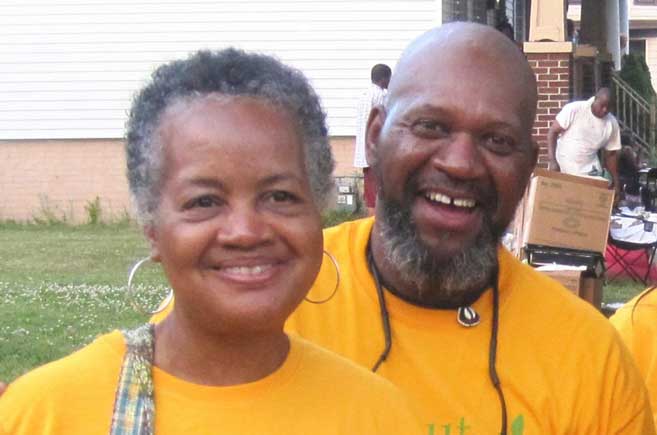Hope Rebuilt: Walnut Way in Milwaukee
Our Northside neighborhood’s journey of restoration has transformed vacant lots into gardens, orchards, and public spaces. These repurposed spaces inspire hope and innovation.
After being away for 27 years, I returned to my childhood community, acting on a desire to reclaim my family home and reconnect with the neighborhood of my youth. I remember the neighborhood of my childhood as a diverse community of German immigrants, Russian-Polish Jews, and African Americans. Small businesses including doctor and lawyer offices jammed commercial streets such as North Avenue and Fond Du Lac. People sat on their porches, visited, and watched out for one another. Backyards were filled with fruit trees and gardens.
By the late 1960s, that neighborhood had disappeared. With the construction of I-43 between Milwaukee and Green Bay, many homes in Lindsay Heights were torn down. The community was the target of redlining; resources stopped coming in; businesses moved out and poverty, blight, crime, and drugs began to take hold. This community that is less than 3 miles from Lake Michigan and City Hall was isolated and devalued.
Until the late 90s, there was virtually no investment in housing and commercial development in the area. This changed with a settlement from Community Reinvestment Act and an infusion of resources by Wisconsin Housing Economic Development Authority (WHEDA) for homeowners to acquire new homes or rehab existing houses. The momentum was building until the foreclosure crisis hit and caused a devastating setback: more demolitions; more vacant lots, and more blight. The blight in this one square mile area home to 2,700 households and 13,000 residents was staggering. Dumping on vacant lots was common practice.
When Larry and I sat on our back or front porches, we saw vacant overgrown properties. We watched people unload debris. Larry would load his truck and head to the City dump. He decided to steward blighted and abandoned land to reveal their marvelous value. In October of 2000, Larry organized the planting of 1,000 tulip blubs with neighbors and friends.
The first production garden was planted in our backyard. Ten truckloads of debris were hauled away from a vacated alley. Youth came for summer programs. Parents cooked breakfast on outside grills. Soil was remediated. Our backyard evolved into a gathering place. Larry studied beekeeping at Growing Power and installed beehives. The honey’s sweet floral flavor was reflective of the great diversity of plants grown. We connected with other neighbors who had beautiful backyard gardens. These actions began the healing and rebirth for our neighborhood. Walnut Way Conservation Corp. acquired and restored a foreclosed house to its vintage properness for a community center. On this block, lot-by-lot, more land for orchards and gardens were acquired. Neighbors joined in planting backyard gardens and installing storm-water catchments. Campaigns for healthy, nutritious food increased public awareness of the oversaturation of fast-food establishments on our commercial corridors. Culturally diverse crops of collard greens, peaches, kale, Cayenne pepper, okra, and honey were harvested. The City passed a beekeeping ordinance.
Our gardens are sacred seasonal places of beauty. Spring is filled with anticipation. The compost produced in our bins and brought in from local farms replenishes the soil. In partnership with the Medical College of Wisconsin and 16th Street Clinic, Walnut Way tests for lead in private gardens and supports healthy growing practices. Products for markets, local restaurants and businesses are grown in our campus gardens.
In the summer, we pass our traditions forward. In partnership with Alice’s Garden, teens are employed as Growing Youth Leaders. They learn cultural gardening traditions and specialize in composing, gardening, beekeeping, and jarring. Volunteer preservers and a hoop house extend the availability of vegetables. In the Fall, we celebrate the Harvest with a street party.
A few years ago, Walnut Way launched Blue Skies Landscaping Employment and Training Services. Residents from our community are employed and trained on the Walnut Way campus in sustainable garden and orchard maintenance. The crew is experienced in environmental landscaping installations. This winter, they installed a festive lighting exhibit in the orchard.
Our restoration is rooted in engaging neighbors and growing coalitions of people who value diversity and prosperity for all. On the horizon is a commercial food-related venture. This summer, the Innovations and Wellness Commons Phase One will open on the North Avenue corridor, creating a food hub and commercial kitchen with partnering tenants, Milwaukee Center for Independence, Outpost Natural Foods, The Juice Kitchen, and Fondy Food Center.
Much has changed. Dumping is almost non-existent. Neighbors, City government, philanthropists and service organizations formed resilient relationships and collaborations focused on public safety, housing, health and wellness, and commercial development. Our stewardship of gardens and orchards advances community engagement, City policy, business, employment and training. Gardens, like our neighborhood, are wonderfully abundant when nurtured.
Larry and Sharon Adams are co-founders of Walnut Way Conservation Corp. The mission of the community development corporation is to sustain economically diverse neighborhoods through civic engagement, environmental stewardship and creating venues of prosperity.






